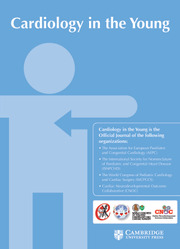No CrossRef data available.
Article contents
The current state of paediatric publishing utilising high-fidelity physiologic data streaming with sickbay or etiometry: a systematic review
Published online by Cambridge University Press: 05 September 2025
Abstract
Physiologic data streaming and aggregation platforms such as Sickbay® and Etiometry are becoming increasingly used in the paediatric acute care setting. As these platforms gain popularity in clinical settings, there has been a parallel growth in scholarly interest. The primary aim of this study is to characterise research productivity utilising high-fidelity physiologic streaming data with Sickbay® or Etiometry in the acute care paediatric setting.
A systematic review of the literature was conducted to identify paediatric publications using data from Sickbay® or Etiometry. The resulting publications were reviewed to characterise them and identify trends in these publications.
A total of 41 papers have been published over 9 years using either platform. This involved 179 authors across 21 institutions. Most studies utilised Sickbay®, involved cardiac patients, were single-centre, and did not utilise machine learning or artificial intelligence methods. The number of publications has been significantly increasing over the past 9 years, and the average number of citations for each publication was 7.9.
A total of 41 papers have been published over 9 years using Sickbay® or Etiometry data in the paediatric setting. Although the majority of these are single-centre and pertain to cardiac patients, growth in publication volume suggests growing utilisation of high-fidelity physiologic data beyond clinical applications. Multicentre efforts may help increase the number of centres that can do such work and help drive improvements in clinical care.
Information
- Type
- Original Article
- Information
- Copyright
- © The Author(s), 2025. Published by Cambridge University Press


